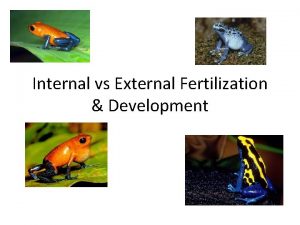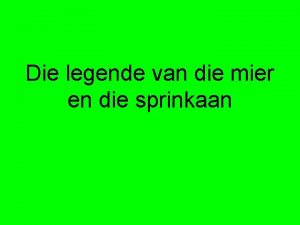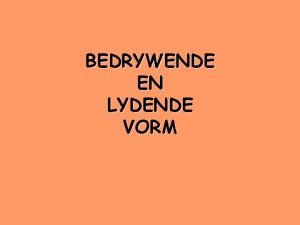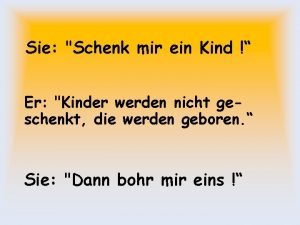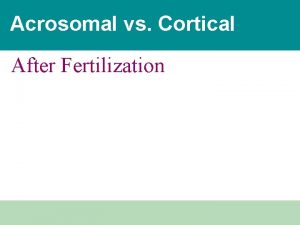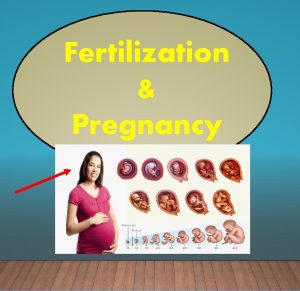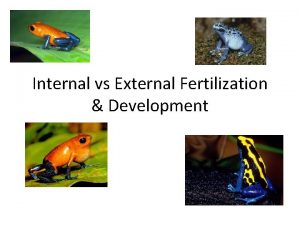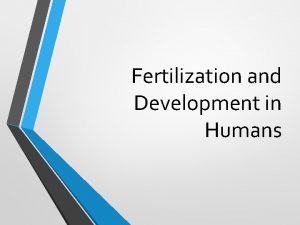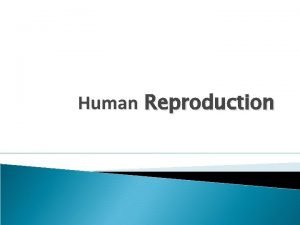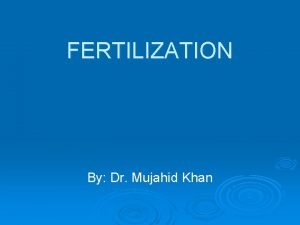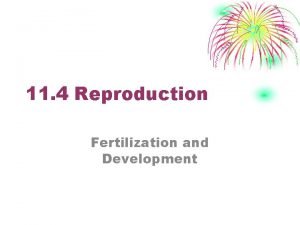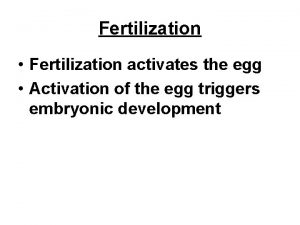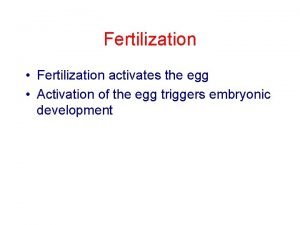Fertilization Eggssperms are destined to die within minutes













- Slides: 13

• Fertilization Eggs/sperms are destined to die within minutes, hours or days unless fertilization occurs. Activation of the egg Fusion of the haploid gametes. Invertebrates: sea urchins and external fertilization. Study internal fertilization in vitro. 1

Species-Specific Binding to the Zona Pellucida Induces the Sperm to Undergo an Acrosomal Reaction • 300, 000 human sperm ejaculated and yet only about 200 reach the egg. • Possibly chemical signals from the follicle cells that surround the egg attract the sperm. • But a sperm cell “ain’t no real sperm cell” until it has been “capacitated” or undergone capacitation • Requires about 5 -6 hours • Triggered by bicarbonate ions in the vagina • The bicarbonate ions enter the sperm and activates an enzyme (adenylyl cyclase) which will convert ATP to c. AMP. • All this serves to: • • • Alter lipid content of sperm plasma membrane. Alter glycoprotein composition of the plasma membrane. Increase sperm metabolism Increase sperm motility Sperm plasma membrane becomes more resistant to stimulation (hyperpolarized) 2

• Now the sperm can penetrate the egg’s follicle cells that surround the egg and bind to the zona pellucida. • ZP normally acts as a fertilization barrier between species. • ZP of mammalian eggs is composed of 3 main glycoproteins • ZP 2 is a long filament • ZP 3 is a long filament responsible for species-species binding of the sperm and therefore may have some receptors. • Possibility of infertility of ZP 3 glycoprotein is absent. • ZP 1 cross links the filaments. 3

4

The Acrosomal Reaction • Contents of acrosome are released by exocytosis. • Contents are released after binding to the ZP and the influx of calcium ions into the sperm’s cytosol. • Hydrolytic enzymes help sperm get through ZP • More sperm surface receptors are exposed so that binding to the ZP 2 protein occurs • This ensures tight binding while the sperm wiggles its way through ZP. • Other proteins are exposed on the sperm’s plasma membrane that help with binding and fusion with egg’s membrane. • Infertility clinics will inject sperm directly into the egg and this will also cause fertilization. 5

6

The Egg Cortical Reaction Helps to Ensure That Only One Sperm Fertilizes the Egg • Many sperm can “bind to the egg, ” but normally one fuses with the actual egg membrane. • Polyspermy results in faulty segregation of the chromosomes during cell division. • Mechanisms to prevent polyspermy • Fast Block: Depolarization of the egg’s plasma membrane • But the egg’s membrane quickly returns to its original charge separation • Slow or Secondary Block: Cortical Reaction of the egg • Calcium ion influx begins egg development • How could you be sure it was calcium ions causing the cortical reaction? • Cortical Granules and Cortical Reaction • Hydrolytic enzymes alter the ZP and “harden” it to prevent polyspermy. 7

The Egg Cortical Reaction Helps to Ensure That Only One Sperm Fertilizes the Egg 8

The Mechanism of Sperm-Egg Fusion is Still Unknown • Fertilin • transmembrane protein present in mouse sperm becomes exposed on the sperm’s surface during the acrosomal reaction. • May have a role in fusion • NH 2 ends are thought to bind to the egg’s plasma membrane. • Fertilin deficient mice are unable to bind to ZP or migrate out of the uterus into the oviduct. • Current Molecular Biology of Contraception: • ZP 3 or Fertilin could be targets. • Basically, just block any small molecules or receptors involved in 9 fertilization.

The Sperm Provides a Centriole for the Zygote • We have a zygote after fertilization • Differentiation • But first the two haploid nuclei must fuse, combine chromosomes to make a true diploid. 10

11

12

• Summary: Mammalian fertilization begins when the _____ of a sperm binds in a ______-specific manner to the _______________ surrounding the egg. This induces the _________ reaction in the sperm, which releases the contents of the acrosomal vesicle, exposing enzymes that help the sperm to digest its way through the _____ to the egg plasma membrane in order to fuse with it. The fusion of the sperm with the _______ induces a _________ ion signal in the _____. The _______ ion signal activates the egg to undergo the ___________ reaction, in which __________________________ release their contents, including enzymes that alter the zona pellucida and thereby prevent the fusion of additional _______. The _______ ion signal also triggers the development of zygote, which begins after sperm and egg _______ nuclei have come together, and their ______________ have aligned on a single mitotic spindle, which mediates the first division of the ________. 13
 Antigentest åre
Antigentest åre Internal fertilization
Internal fertilization Die sprinkaan en die mier
Die sprinkaan en die mier 1 hour and 1 minute
1 hour and 1 minute John o sullivan manifest destiny
John o sullivan manifest destiny Destined synonym
Destined synonym Voorbeelde van voegwoorde
Voorbeelde van voegwoorde Lydende en bedrywende vorm
Lydende en bedrywende vorm Die kinder verbringen die ferien
Die kinder verbringen die ferien Die vorhaut ist die haut spruch
Die vorhaut ist die haut spruch Die einde van die koue oorlog 1989
Die einde van die koue oorlog 1989 Jys die stem in die stilte wat agterbly
Jys die stem in die stilte wat agterbly Die europäer verteilen die welt
Die europäer verteilen die welt Je höher die berge desto schöner die gams
Je höher die berge desto schöner die gams

